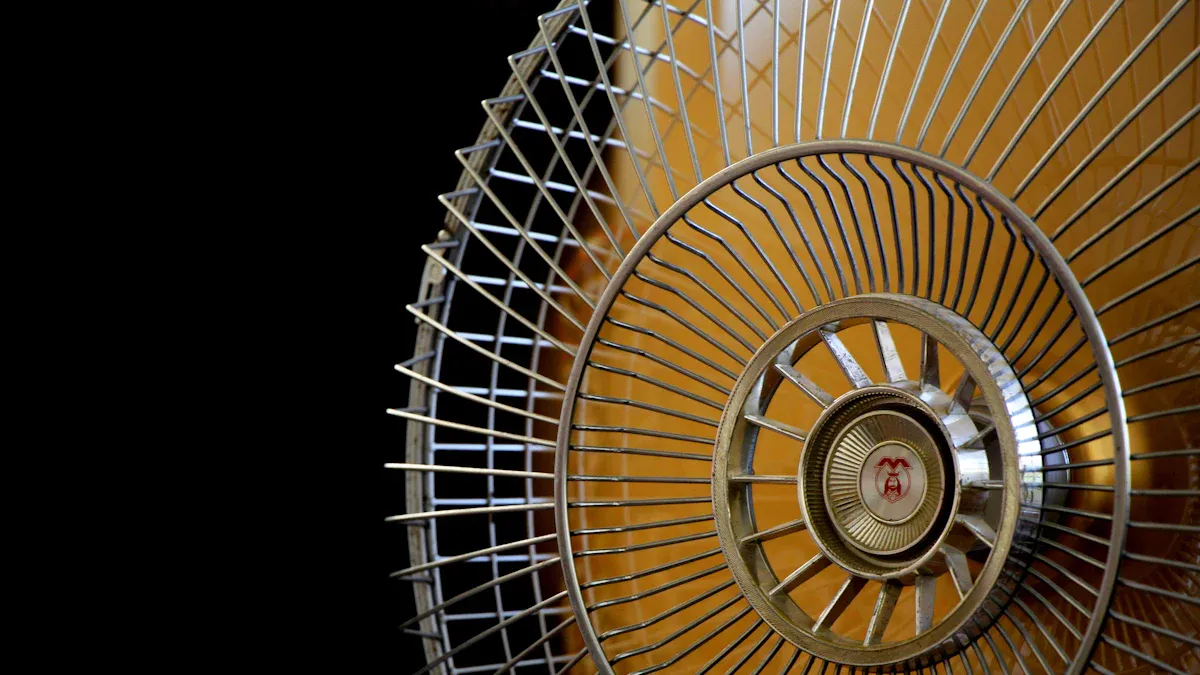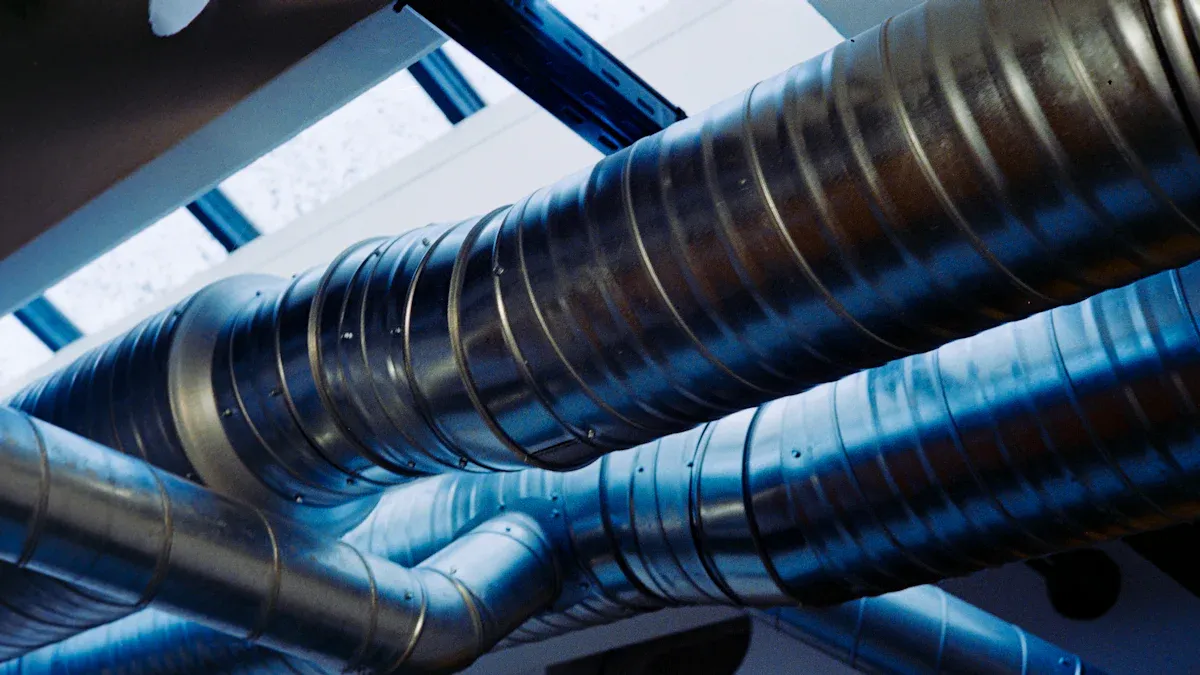The Science Behind Low Temperature Chillers and Their Industrial Applications

A low temperature chiller is a cooling machine for freezing. It moves heat away to keep things very cold. This helps control temperatures exactly, which is important for many jobs. New chillers cut carbon pollution by 12% and save money. They are good for the planet and work well. Industries like medicine and food use them to keep products safe and cool. These chillers are very energy-saving, costing only 0.09€ per kWh to run. They show how to save energy in big industries.
Key Takeaways
Low temperature chillers use less energy and lower costs. They are good for the environment and save money.
These chillers keep exact temperatures, which helps industries like medicine and food stay safe and high-quality.
Picking the right refrigerant matters for working well and helping the planet. Choices like R1234yf are better for nature.
Taking care of chillers often makes them work better and last longer. This saves more money over time.
Low temperature chillers are important for many industries. They provide steady cooling for key processes and products.
Understanding Low Temperature Chillers

Key Components of a Low Temperature Chiller
A low temperature chiller has important parts that work together. The compressor squeezes refrigerant gas to make it hotter and under high pressure. The condenser cools this gas, turning it into a liquid. The expansion valve lowers the liquid's pressure, getting it ready for cooling. The evaporator takes heat away, making the area or item cold.
These chillers can handle different temperature ranges, like [-10°C ~ +25°C] or even as low as [-115°C ~ -65°C]. They are useful for things like evaporators, distillation tools, reactors, and solvent extraction systems. Each part helps control heat, so the chiller works well and lasts long.
Tip: Knowing how a chiller works helps you pick the best one for your lab or factory needs.
The Refrigeration Cycle Explained
The refrigeration cycle is how a low temperature chiller cools things. It follows these steps:
Compression: The refrigerant gas is squeezed to raise its heat and pressure.
Cooling: The hot gas is cooled in the condenser.
Condensing: The gas turns into a liquid.
Subcooling: The liquid is cooled more below its condensation point.
Expansion: The liquid's pressure drops in the expansion valve.
Evaporation: The refrigerant absorbs heat, cooling the area.
Superheating: The gas is warmed slightly before returning to the compressor.
New designs make this process better. Studies show these changes can boost performance by 6.65% and reach a 96.52% energy efficiency. This cycle keeps chillers running smoothly while saving energy.
Types of Refrigerants in Low Temperature Chillers
Refrigerants are what make a low temperature chiller cool. They move heat and power the cooling process. Common refrigerants include R134a, R152a, R290, R600a, R1234ze(E), R1234yf, and CO2. Each has different effects on the environment and costs.
Refrigerant Type | Environmental Impact | Economic Assessment |
|---|---|---|
R134a | High GWP | High costs |
R152a | Lower GWP | Medium costs |
R290 | Low GWP | Low costs |
R600a | Low GWP | Low costs |
R1234ze(E) | Low GWP | Medium costs |
R1234yf | Low GWP | Medium costs |
CO2 | Low GWP | Varies |
For eco-friendly uses, refrigerants like R1234yf and R1234ze(E) are popular because they have low Global Warming Potential (GWP). R-513A is also a good choice as a lower GWP option to R-134a, with better cooling properties. Picking the right refrigerant helps the chiller work well and protects the planet.
Applications of Low Temperature Chillers in Industries

Low temperature chillers are important for many industries. They meet specific cooling needs and keep temperatures steady. This makes them very useful in real-world jobs. Below, you’ll see how they help in pharmaceutical, food, and chemical industries.
Pharmaceutical Applications
In medicine and biotech, exact temperatures are very important. Low temperature chillers keep vaccines, enzymes, and biologics stable and safe. They stop these materials from breaking down during making, storing, or moving. For example, vaccines need very cold storage to stay effective.
Labs also use chillers to keep samples safe and ready for tests. These chillers work well, so samples stay good for testing. Reports show labs are growing fast because they need precise cooling systems.
Note: Using low temperature chillers in medicine keeps products safe and follows strict rules.
Food and Beverage Applications
Food and drink industries depend on chillers to keep items fresh. These chillers stop food from spoiling by keeping it cold. For example, dairy, meat, and frozen foods need steady cooling to stay good.
The market for commercial cooling is growing fast. It was worth $30.5 billion in 2024 and may reach $43.8 billion by 2033. This shows more people need good cooling systems for food safety. Proper cooling stops waste and meets food safety rules.
Benefits of low temperature chillers in food:
Keeps food fresh longer.
Protects the quality of frozen items.
Helps follow food safety rules.
Chemical and Petrochemical Applications
In chemical industries, chillers control heat and keep things safe. Many chemical processes make heat, which can be dangerous or ruin products. Chillers remove this heat and keep conditions steady.
Cryogenics, which deals with very cold temperatures, also uses chillers. They help store and handle gases like nitrogen and oxygen. By cooling exactly, chillers improve chemical processes and protect workers and tools.
Tip: Choosing the right refrigerant for your chiller saves energy and helps the environment.
Application Area | Importance | Growth Segment |
|---|---|---|
Industrial Processes | Needed to control temperatures | N/A |
Clinical Laboratories | Fastest-growing segment in revenue | |
Academic Institutions | Used for experiments needing specific temperatures | N/A |
Government Research Laboratories | Keeps temperatures steady for accurate testing | N/A |
Environmental Applications | Controls temperatures for collecting environmental data | N/A |
Low temperature chillers are key in chemical industries. They meet cooling needs, improve safety, and ensure high-quality results.
Medical and Research Applications
Low temperature chillers are very important in medicine and research. They keep materials and tools at the right temperature. In healthcare, chillers protect blood, vaccines, and biological items. These need steady cooling to stay useful and safe. If not cooled properly, they can spoil and cause big losses.
In labs, chillers help with experiments needing exact temperatures. For example, they cool lasers, microscopes, and other high-tech tools. This stops overheating and keeps equipment working well. Stable cooling helps scientists get accurate and reliable results.
Medical machines like MRI and CT scanners also need chillers. These machines get hot when used, which can cause problems. Chillers remove the heat, helping the machines work better and last longer. They also ensure clear and high-quality images.
Cryotherapy is another use for chillers. This treatment uses very cold temperatures to ease pain and swelling. Chillers cool cryotherapy chambers, making the treatment safe and effective for patients.
In research, chillers help with environmental studies and material testing. They create extreme conditions or test materials at specific temperatures. Their precise cooling makes them very useful in these areas.
Tip: Pick chillers with advanced features for better energy savings and reliability.
Low temperature chillers are key for keeping medical items safe and research accurate. They are vital for precision, safety, and top performance in these fields.
Benefits of Low Temperature Chillers
Energy Efficiency in Cooling Systems
Low temperature chillers save energy and lower costs. They use smart technology to avoid wasting power while working well. For example, modern chillers have compressors that change speed based on cooling needs. This means they use less energy when cooling demand is low.
By using less energy, these chillers cut electricity bills and save money. They are also better for the environment by reducing carbon emissions. Whether you run a lab or a food factory, energy-saving chillers help you save money and protect the planet.
Tip: Take care of your chiller regularly to save more energy and make it last longer.
Precision in Temperature Control
Low temperature chillers keep temperatures steady and exact. This is very important for industries needing reliable cooling. These chillers can hold specific temperatures, improving product quality and keeping processes stable. For example, a chiller with 50W cooling power and a 10L tank cools effectively. It also shows real-time temperatures and cools quickly when needed.
Safety alarms for high or low temperatures make them even more dependable. This accuracy is crucial for storing vaccines, chemical work, and cryotherapy. Even small temperature changes can ruin products or processes.
Feature | Description |
|---|---|
Cooling Capacity | 50W cooling power with a 10L tank for strong cooling. |
Temperature Monitoring | Shows accurate temperatures to check the machine's status. |
Rapid Cooling | Uses forced air to cool down quickly. |
Alarm Functions | Alerts for water flow, high, or low temperatures for safety. |
Note: Picking a chiller with advanced features helps keep temperatures exact and products better.
Reliability in Industrial Applications
Industrial chillers are made to handle tough jobs. Their strong design and smart tech make them dependable for nonstop use. Whether in chemical plants, food factories, or medical labs, these chillers work steadily to meet cooling needs.
Being reliable means fewer breakdowns and lower repair costs. With strong compressors and efficient heat exchangers, these chillers handle hard conditions. This keeps operations running smoothly, which is vital for industries needing stable cooling to protect products and ensure safety.
Tip: Choose a chiller that fits your cooling needs for the best reliability and performance.
Low temperature chillers use the refrigeration cycle to cool things exactly. Parts like compressors and evaporators make them work dependably. These chillers keep very cold temperatures for important tasks.
Industries such as medicine, food, and science use them a lot. They help vaccines stay useful, food stay fresh, and experiments give good results. In chemical work, they make processes safer and more efficient.
Key Takeaway: Low temperature chillers save energy, work precisely, and are reliable. They are must-have tools for jobs needing steady and exact cooling.
🌟 Buying better chillers means improved performance and saving money over time.
FAQ
What industries use low temperature chillers the most?
Pharmaceuticals, food production, and chemical factories depend on these chillers. They provide exact cooling for vaccines, food storage, and chemical tasks. They are also important in medical imaging and research labs.
How do you pick the best refrigerant for your chiller?
Think about the environment, cost, and cooling ability. Eco-friendly refrigerants like R1234yf or R290 are great choices. Always check the Global Warming Potential (GWP) and if it works with your chiller.
Can low temperature chillers help save energy?
Yes, modern chillers use smart tech to save power. Variable-speed compressors and efficient heat exchangers lower electricity costs. Keeping up with maintenance also boosts energy savings over time.
Are low temperature chillers simple to maintain?
Yes, most chillers are built for easy care. Clean filters, check refrigerant levels, and inspect parts like compressors often. Following the maker’s instructions keeps your chiller working well for years.
What safety features should a chiller have?
Look for alarms, water flow sensors, and auto shut-off systems. These features keep your chiller safe from overheating or freezing. Advanced models also offer real-time monitoring for extra protection.
Tip: Pick a chiller with safety features to avoid breakdowns and costly fixes.
See Also
A Comprehensive Guide To Water Chiller Unit Functionality
Proven Strategies To Enhance Walk-In Chiller Performance
Maximizing Efficiency Of Chillers In ARKREF CO₂ Systems
Three Effective Uses For The ARKREF CO₂ Refrigeration Unit
Revolutionizing Goods Storage With Innovative Cold Room Solutions

